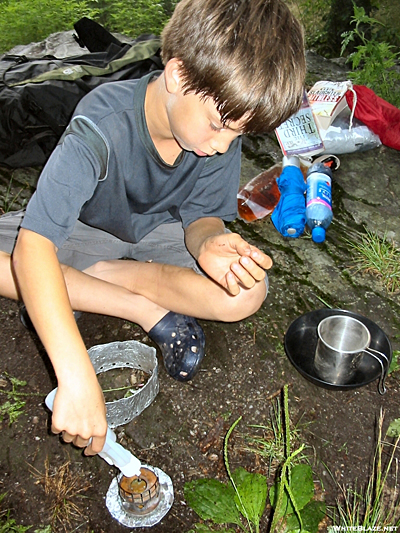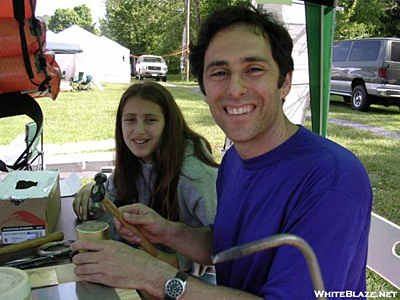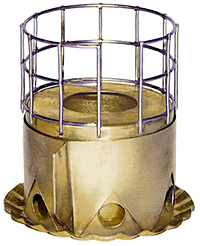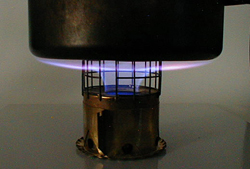
Aaron Rosenbloom on the High Line Trail in Utah's Uinta Mountains in August 2005. (Courtesy of Aaron Rosenbloom)
Aaron Rosenbloom has a hobby with a heart of brass.
He’ll probably never get rich selling his little brass alcohol stoves at Brasslite.com, but that was never the point.
“I made them for myself,” says Rosenbloom, a psychotherapist in suburban Philadelphia who has been a devoted backpacker since 1986.
Like just about any hiker who has wandered the hills west of the U.S. Eastern seaboard, Rosenbloom got the itch early on to hike all 2,175 miles of the Appalachian Trail. He got his first chance in 1991, when he covered 1,700 miles in one season, but his will to complete the trail was sorely tested.
Foot pain from lugging a 50- to 60-pound pack for days and weeks nearly forced him to give up backpacking altogether as he tried to notch more AT miles during ensuing summers.
Rosenbloom’s breakthrough came in 1996, when he read a book by lightweight backpacking evangelist Ray Jardine, who convinced him that lightening his load could silence his complaining feet and let him finish the trail. In the spring of that year Rosenbloom started sewing his own lightweight pack, tent, and clothes. Later in 1996 he completed the AT.
While his backpacking urge endured, his stove-making hobby wouldn’t catch fire until five years later, when he saw mentions of home-made “soda can” stoves in an online chat.
Rosenbloom found one of the designs online, then met a through-hiker a few weeks later who demonstrated how one worked. It wasn’t long till he was hooked on the idea of building pop-can stoves, which dwell in a universe of uncanny ingenuity (see Zenstoves.net for an introduction). The common denominators are alcohol fuel, which is readily available and burns cleanly, and aluminum skin, which has excellent thermal conductivity — the ability to spread heat evenly across its surface.
Aluminum soda-can stoves are feather light and super cheap, but Rosenbloom learned their limitations when he tried to cook on one. It worked fine for a while, then abruptly quit. Pop-can aluminum is too thin to be welded or soldered, so the cans must be taped or glued together. Intense heat weakens the bonds and eventually causes the stoves to fail.
Most stove makers don’t mind: The stoves are so cheap (pennies apiece to produce) and so light (typically less than an ounce) that carrying a spare solves the durability challenge.
Rosenbloom was familiar with metals because he had worked at jewelry making, so he decided to do something about the durability anyway. He first tried to figure out how to weld or solder thin slices of aluminum, but all his attempts failed. Then he tried brass, which is heavier, less thermally conductive and considerably more expensive than cast-off soda cans, but has one winning advantage: parts can be soldered together to build a lightweight stove with substantial staying power.
“The Brasslite stove is not like some big, original idea,” he says. “I’ve just taken ideas I had seen already that people had taught me. I thought, well, I can do this.”
Rosenbloom started cutting, soldering, and taking samples from his brass menagerie on the trail. In the winter of 2001 he took a few prototypes to the PA Ruck, a backpacker gathering in Pennsylvania. Hikers who saw the stoves in action were impressed and encouraged Rosenbloom to market them.

Scott Joiner, 11, son of Steve Joiner of Lawrenceville, Ga., lights his Brasslite stove at a campsite on Georgia’s Cowrock Mountain along the Appalachian Trail in 2007. (Credit: Steve Joiner)
The following year, he took 10 prototypes to the Trail Days AT festival in Damascus, Va., in May. He sold the batch in a weekend. Two months later, Brasslite.com went online and Rosenbloom was in the backpacking stove business, crafting the first 500 in his workshop until a three-month backlog at the end of 2002 convinced him he needed a better way to get them built.
That was when his little brass stove gave him a window on the realities of global commerce.
A hiking partner who did business overseas took Rosenbloom’s stove to Vietnam and found a craftsman willing to build Brasslite stoves. After his artisan died unexpectedly in 2006, Rosenbloom tried China, where unscrupulous operators ripped him off twice. Friends in India helped connect him with a new manufacturer who builds them today outside of New Delhi.
In the boom years of 2004 and 2005, Rosenbloom was selling 200 Brasslites a month, wholesaling them to six stores and six to eight websites. Today they’re sold at two stores and two websites and sales are off considerably. Rosenbloom still spends 10 to 12 hours a week answering buyers’ questions and inspecting every stove before he packs and ships it, on top of his full-time job as a psychotherapist.
Rosenbloom’s website (www.brasslite.com) describes alcohol stoves’ advantages over canister and white-gas stoves. Beyond their light weight, they burn cleanly and quietly with fuel available just about anywhere. Alcohol doesn’t burn nearly as hot as white-gas or canister stove fuel, so it requires patience and determination – the same qualities needed to finish a long trek, which helps explain the appeal to through-hikers.
“The Brasslite stove made something that you could use the same way every single time and expect it to perform the same exact way,” said Ernest Engman of Maryville, Tenn., who runs the Hiking HQ and Whiteblaze discussion boards, where he posts under the handle Sgt. Rock. Engman admires Rosenbloom’s stoves but does not use them on the trail: he cooks with a .42-ounce creation of his own design called the Ion Stove (Brasslites weigh 1.9 or 2.8 ounces).

Aaron Rosenbloom demonstrates stove making at Trail Days 2004 in Damascus, Va., alongside his daughter, Leah. (Credit: MedicineMan — Whiteblaze.net)
“To me the stove that is the absolute lightest and most fuel efficient at the same time, while being the simplest to operate, is where to go,” Engman said. “Others don’t mind carrying a few extra parts if their stove cooks faster and are less concerned about fuel efficiency.”
Other gram-counters would just as soon let somebody else build their stoves.
“I like my Brasslite stoves because they work,” said Steve Joiner, a backpacker from Lawrenceville, Ga., who has been cooking on the stoves since 2003. “I'm pretty compulsive by nature, and know if I started trying to make my own stoves, it would be a never-ending pursuit to marginally improve something that worked immediately out of the box.”
Alcohol stoves’ limitations have caused a few hikers to give up on them. “I was never a big fan of alcohol, and always found it a little messy,” said Ellie Thomas of Wilton, Conn., a veteran through-hiker who goes stoveless on her long treks these days. “It was also slow in cold weather. I do still have my little Brasslite stove that I used on part of the AT. It is a tough little stove that has held up well.”
The first Brasslite stoves, the Micro and Solo, were clever but complicated, requiring a pointed bottle to pour fuel through a small opening on the top and a screw to seal the opening. Before long Rosenbloom developed the simplified Turbo line, which was easier to fuel and added a layer of metal that rotates around the stove’s base, regulating the flame by reducing airflow. This lets food simmer on the stove, a sophisticated option for alcohol stoves, which typically allow one burn at one temperature until all the fuel is gone.
Rosenbloom’s current product line consists of just two stoves – the Turbo I-D ($30) and the Turbo II-D ($40) – and a few accessories. The latest design is unchanged since 2004. Rosenbloom is fine with that.
“There’s a number of people who’ve through-hiked the PCT and the Continental Divide and the AT with my stoves, and what I keep hearing is they’re so simple that there’s nothing to go wrong with them. It just keeps working,” he says. “So as far as the design goes, if it ain’t broke don’t fix it.”

 by Tom Mangan
by Tom Mangan











